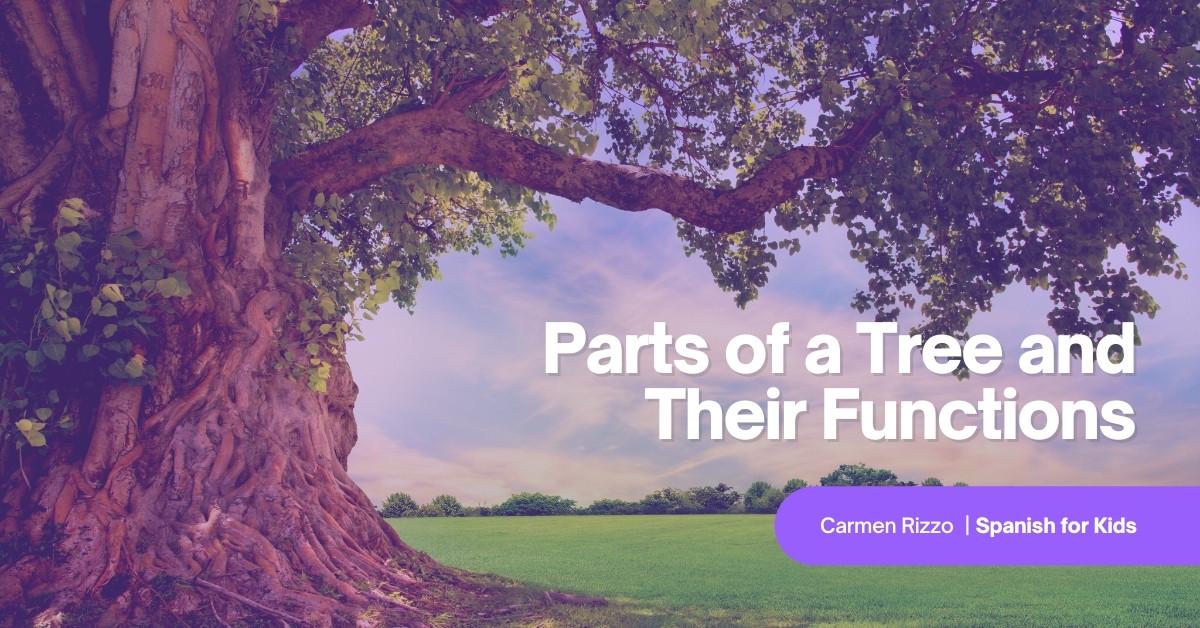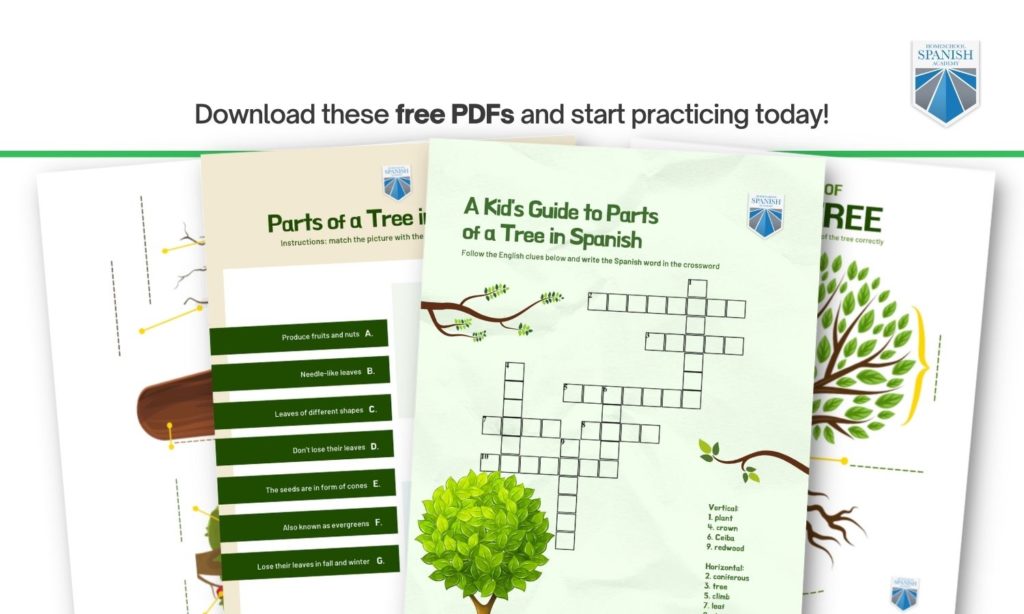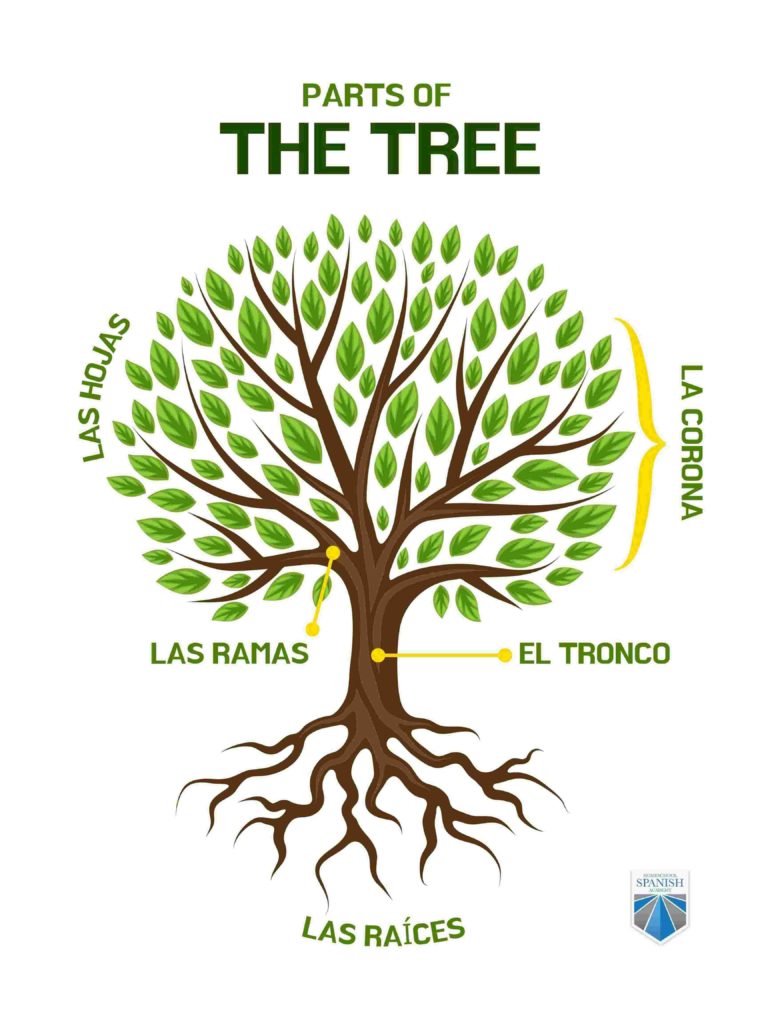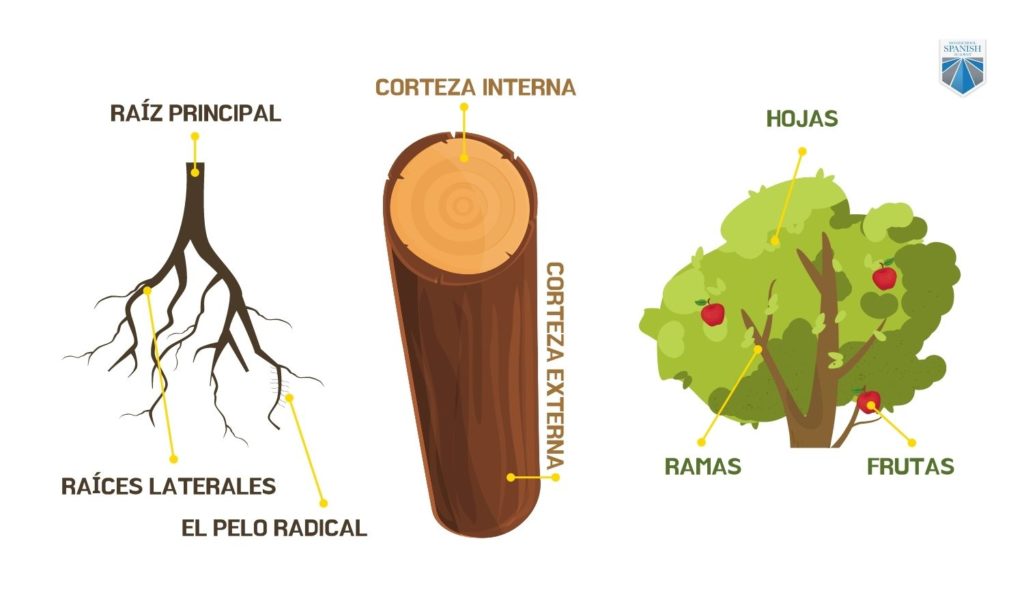
Parts of a Tree and Their Functions (Free Spanish Lessons for Kids)
Los árboles (trees in Spanish) are key elements in nature, and each part of a tree plays an important role.
A tree is a perennial woody plant with a trunk that grows to a considerable height. Trees also have lateral branches that grow some distance from the ground.
Trees are important for ecosystems and nature in general. People love to climb trees and use them for shade on hot days. They’re also wonderful ornaments for our gardens.
Trees are essential all around the world! Let’s learn about trees and the parts of the trees in Spanish and discover why they are critical for the environment and for human and animal life.
Explore more FREE SPANISH LESSONS FOR KIDS!
Enjoy over 70 unique lessons + free activity packets to download.
Types of Trees (Tipos de árboles)
There are around 60,000 species of trees on Earth!
Brazil has the most tree species in the world, with around 8,700 types of trees. Meanwhile, the Arctic region is home to less than 1,400 tree species.
Here’s a brief list of types of trees in Spanish, so you can talk about your favorite trees with your friends and family.
| English | Spanish |
| apple tree | el manzano |
| ceiba tree | la ceiba |
| eucalyptus tree | el eucalipto |
| orange tree | el naranjo |
| palm tree | la palmera |
| pine tree | el pino |
| spruce palm | la palma de abeto |
With so many species, tree experts divide trees into categories. Today, we’ll learn about two of these categories: deciduous and coniferous.
Deciduous Trees (Árboles de hoja caduca)
Los árboles de hoja caduca (deciduous trees) usually produce fruit or nuts, and during winter they go dormant. These trees are also known as hardwoods.
Deciduous trees shed their leaves in autumn and regrow them in spring. Their leaves have different shapes and sizes, like ovals, stars, and hearts.
| English | Spanish |
| alder | el aliso |
| aspen | el álamo temblón |
| birch | el abedul |
| cherry | el cerezo |
| deciduous trees | los árboles de hoja caduca |
| elm | el olmo |
| mahogany | la caoba |
| maple | el arce |
| oak | el roble |
| sycamore | el sicomoro |
Coniferous Trees (Los árboles coníferos)
Los coníferos (coniferous trees) have their leaves in the form of needles. These evergreens retain their leaves all year long.
They usually don’t produce fruit or nuts, and their seeds are hard and usually cone-shaped.
| English | Spanish |
| cedar | el cedro |
| coniferous tree | los árboles coníferos |
| cypress | el cipres |
| fir | el abeto |
| hemlock | la cicuta |
| larch | el alerce |
| pine | el pino |
| redwood | la secoya |
| spruce | la picea |
| yew | el tejo |
Download your free worksheets to review the two types of trees you’ve learned about today!

Download FREE Trees in Spanish Activities for Kids!
Type your name and email below to get four activities for kids about the trees in Spanish! You will receive: Parts of the tree worksheet, matching worksheet, and crossword puzzle.
Explore more FREE SPANISH LESSONS FOR KIDS!
Enjoy over 70 unique lessons + free activity packets to download.
Parts of the Tree (Las partes del árbol)
While there are a lot of species and types of trees in Spanish, almost all tree species share the same parts which help them to have the same functions and roles in nature.
Let’s remember the parts of the tree and learn them in Spanish!
| English | Spanish |
| branches | las ramas |
| crown | la corona |
| leaves | las hojas |
| roots | las raíces |
| trunk | el tronco |

To understand better the parts and functions of a tree, let’s began from the bottom to the top:
Roots (Las Raíces)
Roots are the first thing that come out of the germinated seeds after a tree seed begins to grow.
The roots have two important roles as part of the trees:
Mantener al árbol recto
Keep the tree upright
Recolectar agua y nutrientes para el árbol
Gather water and nutrients for the tree
When the seed begins to germinate, the first root, called la raíz principal (taproot) develops. Taproots are thick and grow straight down into the earth.
From the taproot, smaller and thinner roots called las raíces laterales (lateral roots) develop. Lateral roots may be longer than the taproots, and they grow horizontally..
When the tree grows and reaches maturity, the taproot withers away.
Near the tips of the roots are fine roots called el pelo radical (root hair) absorb water and nutrients for the tree.
Roots need oxygen to survive. Only a few tree species are able to survive with their roots submerged in water.

Trunk (El tronco)
El tronco (trunk) is the main structural element of a tree. Trunks are hard and sturdy, as they must support the weight of the tree.
The trunk’s job is to:
Sostener las ramas y el follaje
Support the branches and foliage
Conectar las raíces con las ramas y el follaje
Connect the roots with the branches and the foliage
La corteza (tree bark) covers most trees trunks. La corteza interna (inner bark) transports the nutrients and elements that enable to the tree to live. On the other hand, la corteza externa (external bark) protects the tree.
Crown (La corona)
La corona del árbol (the crown of the tree) is the area where the branches grow from the trunk.
In winter, deciduous trees lose all their leaves, and only the crown of branches survives. The branches grow brotes (buds) at the points where they grow leaves. The buds have scales that help protect them from the harsh winter weather. In spring, the buds slowly open to reveal leaves and flowers.
The crown is composed of las ramas (the branches) and the primary role of these is to:
Hacer crecer las hojas
Grow the leaves
Sostener las hojas
Hold the leaves
Leaves (Las hojas)
Las hojas (leaves) are like the food factory of a tree. They produce food for the tree in a process called photosynthesis, where the leaves transform sunlight and water into energy.
In the autumn, most trees shed their leaves and don’t regrow them until the first days of spring.
Leaves have two important roles:
Hacer fotosíntesis para producir alimento para el árbol
Undergo photosynthesis to produce food for the tree
Producir oxígeno
Produce oxygen
Example Sentences in Spanish
Let’s describe the parts of a tree!
Las raíces del árbol son muy largas.
The tree roots are really long!
¡El tronco del árbol es fuerte!
The tree trunk is strong!
Las ramas del árbol están frondosas.
The branches of the tree are bushy.
Las hojas de los árboles son coloridas.
The tree leaves are colorful.
Trees in Spanish Learning Activities
To keep practicing and reviewing the lesson content, remember to download our parts of the trees worksheets above.
Wangari y los árboles de la paz (Wangari’s Trees of Peace) and El viaje de Papelote (The journey of Papelote) are two simple books for kids ages 5 to 12 with beautiful illustrations and a powerful message of the importance of the trees and nature.
To review the content of this lesson, check out this video on the parts of the tree in Spanish by Yogotars educational videos.
Let’s Keep Learning
Our world is huge and full of natural diversity. Just look at how many types of trees are out there! And just like trees, we humans are also a diverse species. Spanish is a great way to expand your child’s global awareness and help them understand diversity! Learning a new language opens our eyes to a world full of new cultures, words, and friends. It also teaches them to respect and celebrate diversity.
What’s more, young children have an incredible ability to pronounce foreign and unfamiliar sounds and understand complex grammar rules. The earlier they begin, the easier it is for them to learn—although any age is a great time to start! To see for yourself how quickly your child can learn Spanish, sign up for a free trial class with one of our certified, native-speaking teachers at Homeschool Spanish Academy.

Join one of the 40,000 classes that we teach each month and you can experience results like these

“This is the best way for your kid to learn Spanish. It’s one-on-one, taught by native Spanish speakers, and uses a curriculum.”
– Sharon K, Parent of 3

“My Son, Heath, is taking the classes. He’s been with Luisa the entire time and we absolutely love her. She is always patient and is a great teacher. Heath’s dad speaks Spanish so they get to have little conversations.”
– William R, Parent of 3

“HSA offers very affordable, quality, one on one classes with a native speaker. My son has greatly benefited from taking classes. We have seen his confidence increase as well as his pronunciation improve, because he learns from a native Spanish speaker. HSA has quick, personal customer service. Our family has been very pleased with our experience so far!”
– Erica P. Parent of 1
Want more free Spanish lessons, fun content, and easy learning strategies for kids? Check these out!
- How to Create a Daily Homeschooling Routine Using Spanish Fluency Games for Kids
- Boost Your Child’s Spanish Skills with These Family-Friendly Games
- How to Help Your Child Speak Spanish with Confidence (Without Feeling Embarrassed!)
- The Best Spanish Learning Podcasts for Kids
- Spanish for Middle Schoolers: The Perfect Age to Start (Here’s Why!)
- How to Make Learning Spanish Fun for Kids: 7 Engaging Activities
- Why Early Spanish Learning Gives Your Child a Head Start in School
- The #1 Mistake Parents Make When Teaching Kids Spanish (And How to Avoid It)
- An Easy Vocabulary Guide to Describe the Post Office in Spanish - February 10, 2023
- Guatemala’s Biggest, Most Colorful Market: Chichicastenango - December 28, 2022
- 8 Sad Spanish Songs for When Your Heart Is Broken - December 6, 2022






